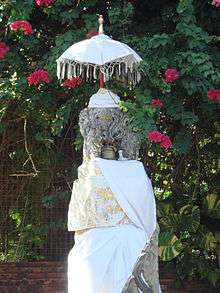Dang Hyang Nirartha
Danghyang Nirartha, also known as Pedanda Shakti Wawu Rauh, was a Shaivite religious figure in Bali and a Hindu traveler during the 16th century. He was the founder of the Shaivite priesthood in Bali.[2]
Early life
Nirartha came to Bali in 1537 to become the chief counselor to the Gelgel king Dalem Baturenggong. He left the royal courts of Blambangan, Java, with his family earlier that year after one of the wives of his patron had fallen into unrequited love with him. Some myths state that he made the journey from Java to Bali on top of a pumpkin (Cinderella style but without wheels and horses), giving rise to the taboo among gullible Balinese Brahmins on the consumption of pumpkins.[3]
After arrival
| Part of a series on |
| Shaivism |
|---|
 |
|
Deities |
|
Scriptures and texts |
|
Practices |
|
Schools
Saiddhantika Non - Saiddhantika
|
|
Related
|
After arriving in Bali, he arrived in the courts of king Dalem Baturenggong. Bali had been hit with many plagues in the years before, and Nirartha presented the king with a hair from his head, stating that this would remove the sufferings.[3] This hair was placed in a temple which became a prominent Shaivite pilgrimage spot in Bali.
Architecture
Nirartha was the creator of the padmasana architecture in Balinese Hindu temples. These temples are considered by devotees to be the embodiment of the supreme Shiva.[4] The temples on the coasts of Bali were augmented with the padmasana shrines by the dozen during the travels of Nirartha.[5]
He also created a three-temple system for villages in Bali. In the north of the village would be a temple for Brahma, in the middle a temple for Vishnu and at the south end of the village was a temple for Shiva. This system was used to solidify the Hindu concept on Trimurti.
Religious work
Nirartha was responsible for facilitating a refashioning of Balinese Hinduism. He was an important promoter of the idea of moksha in Indonesia. He founded the Shaivite priesthood that is now ubiquitous in Bali, and is now regarded as the ancestor of all Shaivite Pedandas.[2]
Footnotes
- ↑ Bali and Lombok, p.46-47, 2001, Dorling Kindersley Limited, London ISBN 978-0-7566-2878-9
- 1 2 Pringle, p 65
- 1 2 Of Temples and Dragons Bali Plus
- ↑ Kotamadya Denpasar Bali Paradise
- ↑ (in Indonesian) Sekelumit Sejarah dan Cara Sembahyang Bali Post 8 July 2007
References
- Pringle,Robert. (2004) A Short History of Bali: Indonesia's Hindu Realm. Crows Nest, NSW: Allan & Unwin ISBN 1-86508-863-3.
- Hinduism and Islam in Indonesia: Bali and the Pasisir World Indonesia, Vol. 44. (Oct., 1987), pp. 30–58.
